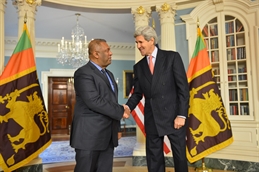
When Sri Lankan Foreign Minister Mangala Samaraweera made a road trip to Washington in February, his goal was to build better relations and economic bonds with the US and attract investment.
With the new Sri Lankan government only in power since January this year, Samaraweera spoke strongly about the need for a peaceful transition of government in his country. “We elected our new president by ballot, not bullet,” he said.
While in Washington, he met with US Secretary of State John Kerry and members of the press.
While the US is the single largest export market for Sri Lanka (33%), relations between the two nations have not always been good. In recent years the United States has been critical of Sri Lanka’s human rights record brought on by decade’s long civil war that finally came to a halt in 2009.
Nevertheless, scores of US companies base their operations throughout Sri Lanka, making the United States Sri Lanka’s second largest foreign direct investor behind China.
To set the new government on a different track, its leaders have presented an ambitious 100-day program that includes “far-reaching democratic reforms and constitutional amendments.” The program is expected to be in place in March.
In addition, the new government is making efforts to wean its reliance away from funding from China. Samaraweera insisted to the media in Washington that the Sri Lanka government is re-examining key projects in which China plans to invest, such as the US$1.5 billion Port City project in Colombo. But reports later indicated that, despite hesitations, the government is still allowing China to push ahead with the project that is said to have become a symbol of Chinese influence on Sri Lanka.
India, in particular, has concerns about the project, however. The Telegraph of Kolkata reported in January that the Indian government views the project “as a critical component of Chinese President Xi Jinping’s proposed Maritime Silk Route – a new, Beijing-dominated sea trade corridor.”
The Chinese were also responsible for building a US$500 million container terminal at Port Colombo, which opened there in 2013. China Development Bank provided a US$350 million loan to terminal operator China Merchants Holdings International. The Hong Kong conglomerate holds an 85% stake in the terminal.
The terminal is billed as being able to handle 2.4 million containers a year and as part of Sri Lanka’s plan to add 7.2 million boxes of capacity and deeper berths at its main port to attract larger vessels.
But Samaraweera stressed that many of those projects do not follow proper procedures. “In fact, the Port City project did not go through the proper environment assessments,” he emphasized. “Now such projects will be reviewed.”
He added, however, that the Chinese-built the port projects were and are not under review because they were and are Chinese-funded, developed, and operated.
Seaports are critical to Sri Lanka’s US$76 billion economy. Its garment industry alone is worth some US$4.5 billion. Other important exports are tea, apparel, textile, rice production and other agricultural products.
Sri Lanka enjoys a strategic location for logistics. Located midway in the Indian Ocean on one of the world’s busiest international shipping lanes, the country is already a key transit point for cargo.
That is one reason Samaraweera stressed in Washington that Sri Lanka needs more than foreign aid, development and high interest loans from China. “We are seeking more investment from countries like the United States,” he said. “We welcome foreign direct investment, and I hope that now that Sri Lanka is creating the environment conducive for investors, more will come.”
Samaraweera noted that Sri Lanka faces competition from other South and Southeast Asian nations, pointing out that Myanmar, for example, is currently attracting a great deal of FDI after spending years as a pariah country under its former military government. “They are not the only girls on the beach,” he said.
While the new Sri Lanka government is still getting a handle on what it will offer in terms of incentives, Samaraweera emphasized that what held FDI back under the last government was the world view that Sri Lanka was an emerging dictatorship. “The country cultivated oppression and suppression of the media,” he said.
Today he maintains that the first step for attracting FDI is ensuring that Sri Lanka’s rule of law and democratic fundamentals are re-established. “Beyond that, there will also be many incentives.”
By Karen E Thuermer
Correspondent | Washington



